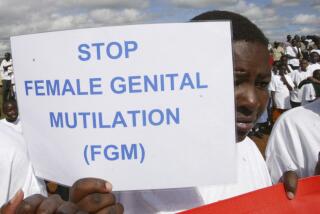HIV and circumcision
- Share via
My downstairs neighbor, eight months pregnant, recently stopped me in the elevator to share her dilemma about whether to have her baby boy circumcised. For a growing number of American parents today -- particularly in urban centers like Los Angeles and New York -- the decision to cut or not to cut is not the foregone conclusion it used to be.
Forty years ago, the circumcision rate for newborn boys in the United States was 85%; today, according to the Agency for Healthcare Research and Quality, it’s about 56%, as more parents rethink whether circumcision is -- or ever was--necessary.
In sub-Saharan Africa, attitudes are moving in the other direction. There, circumcision is gaining a hold in communities where historically it has not been practiced, and there is good reason for the shift.
Irrefutable evidence now shows that male circumcision can reduce the risk of heterosexual HIV transmission by as much as 64%. The findings were so dramatic that National Institutes of Health clinical trials were stopped early because researchers deemed it unethical to deny the procedure to men in the control groups.
The data also compelled the governments of Botswana, Kenya and Rwanda -- countries where HIV is epidemic -- to endorse male circumcision in their health policies, a bold move in places with a multitude of ethnic groups unaccustomed to the idea. In Zambia, the government has launched a mass effort to increase access to hospital-based circumcision.
What’s exciting about male circumcision as a way to reduce HIV risk is that it does not involve vaccines or new technologies, which regrettably are years away. Circumcision, which has been around for millenniums, could help fill the gap; however, like any public health initiative, it doesn’t mean there won’t be challenges in implementing it.
This is why, in countries where HIV devastates millions of lives, circumcision policies must be supported with appropriate resources, and government and health leaders must work with practitioners on the ground to make sure that the procedure is wholly beneficial and in no way harmful.
My neighbor, like other U.S. parents, knows that if she opts for the procedure, it will be performed safely, in a clean surgical environment, with anesthesia and antibiotics. This is not the case in places where HIV hits hardest. Support is needed in regions where health systems are weak so that health professionals are properly trained to perform circumcisions and always use sterile instruments.
What’s more, to be truly effective, circumcision must be offered as part of an overall HIV prevention strategy, not as a stand-alone service. Information is essential: Men must understand that circumcision won’t make them immune to HIV or other sexually transmitted infections, and that condom use is still crucial.
Without that kind of information campaign, male circumcision actually could be harmful for women in two key ways. First, men who are circumcised may believe that they do not need to use condoms. Second, money currently spent on HIV prevention efforts that involve and benefit both women and men may be shifted disproportionately to one that serves only men.
The science supporting male circumcision as an effective form of HIV prevention for female-to-male transmission is conclusive in countries with high rates of HIV. But it will take thoughtful planning on the part of policymakers and program managers to increase its availability. They must remember that, as with many public health efforts, what works in one community may not be appropriate in another, even for a practice as commonplace as circumcision.
Take the U.S., for example. When it comes to preventing HIV, the benefits of male circumcision are less clear. Here, HIV prevalence is markedly lower than in countries that are actively promoting the practice. And in the U.S., barely a quarter of HIV cases result from high-risk sex between men and women, which is the predominant mode of transmission in Kenya, Zambia and across Africa.
But for those to whom male circumcision makes sense, whether in a pediatric ward in Long Beach or a family clinic in Lilongwe, Malawi, there must be two constants: high-quality care and informed choice. Governments in particular have a careful line to toe as they promote circumcision -- one that remains respectful of existing traditions while ensuring safety for all men and boys who undergo the procedure, whether at the hands of a village elder or in the district hospital across the river.
As for my neighbor, she was grateful to still have one month to mull over her decision. What gave her comfort was knowing that her choice would be based on having full information and that her son would receive high-quality care. These are two factors that should never be compromised for anyone, anywhere.
Paul Perchal is the director
of the HIV/STI Program for EngenderHealth, a global reproductive health organization active in more than 25 countries.
More to Read
A cure for the common opinion
Get thought-provoking perspectives with our weekly newsletter.
You may occasionally receive promotional content from the Los Angeles Times.





